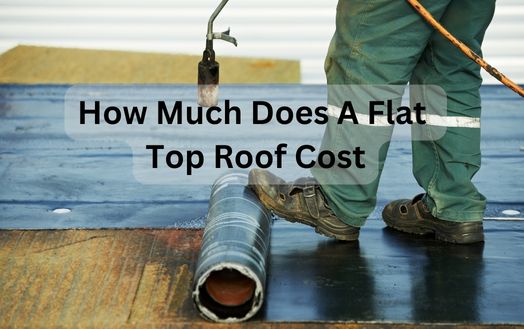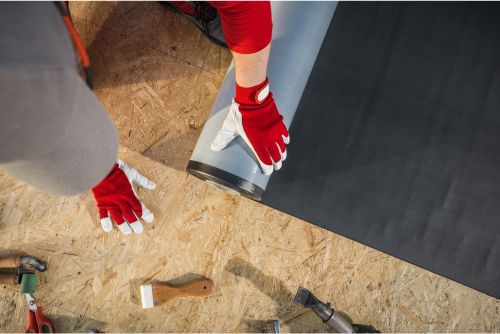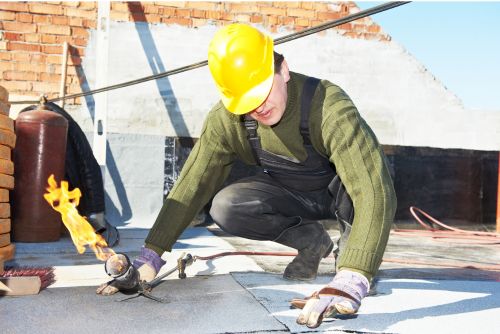
Did you know that the cost of a flat top roof can vary significantly depending on several factors? As a professional in the construction industry, I have come across many homeowners who are surprised by the range of prices they encounter when considering a flat roof installation or replacement.
In this discussion, we will explore the various factors that can influence the cost of a flat top roof, including the size of the roof, the materials used, and the complexity of the installation process. But that’s not all – we will also delve into cost-saving measures and long-term maintenance expenses that homeowners should consider.
So, let’s dive in and uncover the key aspects to understand how much does a flat top roof cost.
The size, materials, and modifications of a flat-top roof can affect its cost. These factors greatly impact flat roof costs.
Due to its impact on installation materials and labor, the size of the roof is crucial. Installation costs rise with roof size.
Material choice is also important. Green roofs and solar panels may cost more, but they can save money in the long run. Consider the materials’ durability, energy efficiency, and maintenance needs to make an informed choice.
Labor costs are also significant for flat roofs. Proper installation requires skilled labor, which can affect roof quality and longevity. A successful flat roof installation requires experienced professionals who understand the nuances.
Skylights, roof access points, and other modifications can increase costs. These innovative roof features improve functionality and aesthetics, but they require more materials and labor.
The cost of installation and materials depends on the size of the roof. The size of flat roofs is measured in square feet. The cost of installation rises with roof size because more materials are needed. A bigger roof needs more labor, insulation, and waterproofing.
Roofing contractors will need more time to install a larger flat roof. It will take longer to prepare the surface, apply layers, and seal everything. The price will reflect this higher labor cost.
Material costs also depend on the size of the roof. Insulation and waterproofing for a larger roof are expensive. The roof size will also increase the cost of transporting these materials to the site.
However, larger roofs may benefit from economies of scale. Roofing contractors may offer discounts for larger projects to offset additional costs.

Let’s examine flat-top roof materials. Several innovative flat roofing materials offer durability and aesthetics. Consider these four popular options:
The average cost of flat roofing materials should include installation, maintenance, and durability. Each material has pros and cons, so choose the one that fits your needs and budget.
Flat-top roof installation requires planning and skill. Flat roof installation is complicated by several factors. Roof material is important. Materials have different installation requirements, which can affect installation time and effort.
Flat-top roofing costs depend on the complexity of the installation. The average cost of flat roof installation includes materials and labor. The complexity of roof installation may require more time and effort from the roofing contractor, increasing labor costs.
A roofing contractor is essential for installation. Installing the roof correctly and efficiently requires their expertise and experience. They plan and execute the installation process, considering the flat roof and material.
Hire a reputable and experienced roofing contractor for a successful flat roof installation. They’ll know how to handle the roof’s complexity and install it properly. The complexity of the installation process may increase the cost, but it’s worth it to maintain your flat roof.
The cost of a flat-top roof depends on many factors. Flat roof prices vary depending on size, materials, installation complexity, and location. Let us find out how much does a flat top roof cost.
Consider these key points:
An average flat roof costs $5,000 to $15,000 or more. However, these costs are estimates and may vary depending on the above factors. A professional roofing contractor can provide an accurate flat roof replacement cost estimate. They can assess your needs and provide a detailed cost estimate.

Flexible design and functionality are advantages of flat-top roofs. Consider the pros and cons of a flat-top roof when calculating its cost.
For innovative designs, flat roofs are popular because of their sleek, modern look. They can be tailored to any architectural style, allowing endless creativity. Due to their flat surface, these roofs can accommodate rooftop gardens, solar panels, and outdoor living spaces, maximizing space.
Another benefit of flat-top roofs is affordability. Compared to pitched roofs, flat roof replacements are cheaper. Flat-top roofs are attractive for commercial buildings, especially for cost-effective roofing.
However, flat-top roof cons must be considered. They leak easily, which is a major drawback. Without a slope, water can accumulate on their surfaces, causing leaks and damage. Regular maintenance and inspections help identify and fix problems quickly.
Flat-top roofs may need more insulation to retain heat. Energy efficiency can be compromised without insulation, raising heating and cooling costs. Investment in quality insulation materials maximizes energy efficiency.
Let’s examine flat-top roof labor costs. Labor costs are important when calculating flat roof costs. Consider these key factors:
When estimating flat roof labor costs, these factors are essential for a precise budget. Understanding labor costs helps you plan your project and avoid surprises.
Consider material prices, installation requirements, and long-term maintenance costs when comparing flat roof materials. There are many flat-roof systems with different benefits and costs.
Flat concrete roofs are popular and affordable. Concrete resists harsh weather and requires little maintenance. Its price depends on the concrete thickness and roof size. Due to their durability and low maintenance, flat concrete roofs are cheaper than others.
Membrane roofs made of EPDM or PVC are another option. The materials are lightweight, flexible, and easy to install. Membrane roof prices vary by material and size. Although membrane roofs cost more than concrete, they are waterproof and last longer, reducing the need for repairs and replacements.
When comparing flat roof materials, long-term maintenance costs are crucial. Regular inspections and repairs can increase the cost of some materials. However, a high-quality, low-maintenance material can save money over time.

Consider installation and maintenance costs when considering flat-top roof projects. Material type, roof replacement, and project requirements affect these costs.
Here are some additional flat-top roof project costs to help you understand the overall costs:
These extra costs will help you estimate your flat-top roof project’s total cost. Understanding and planning for these costs will ensure a successful and innovative roofing solution for your property.
Consider several factors when budgeting for a flat-top roof to get an accurate estimate. Planning your budget is important because the cost of a flat-top roof depends on the materials, size, and installation complexity. Budget for your flat-top roof project with these tips.
First, find out what a flat-top roof costs in your area. You can start with this and set a realistic budget. Consider market prices for materials, permits, and labor.
Second, consider the lifespan of your flat-top roof materials. Due to their durability and low maintenance, some materials may cost more upfront but save money over time. Weather resistance, energy efficiency, and warranty should also be considered when choosing roofing materials.
Next, consider installation costs. These can include unexpected structural repairs or insulation additions. Contingency funds for unexpected expenses are always a good idea.
Finally, get an accurate flat-top roof estimate from a professional roofing contractor. They can offer valuable insights and advice on project requirements and costs.
Consider getting multiple quotes for cost comparison after carefully budgeting for your flat-top roof project. These steps are essential to getting the best deal and value for your money. There are four reasons why multiple quotes are necessary:

There are several factors that influence the cost of flat roof replacement. When it comes to the cost of replacing a flat roof, there are a few key factors that play a significant role in determining the final price. One of the main factors is the size of the flat roof. The larger the roof, the more materials and labor will be required, which will increase the overall cost.
Additionally, the type of material used for the replacement is another important factor. There are various options available for flat roofs, including EPDM, TPO, and PVC, each with its own cost.
The complexity of the roof also affects the cost. If the roof has multiple levels, slopes, or unique architectural features, it will require more time and effort to replace, and therefore, the cost will be higher.
Another factor is the condition of the existing roof. If the roof has extensive damage or structural issues, it may require additional work and repairs, which will increase the cost of replacement.
Finally, the location of the property can also impact the cost. Factors such as accessibility, local labor rates, and regional pricing differences can all play a role in determining the final cost of flat roof replacement.
I’ve found ways to cut flat-top roof costs. There are four ways to save money on flat-top roof projects:
Flat-top roofs need ongoing maintenance to last and avoid costly repairs. The long-term maintenance costs of a flat-top roof should include roof repair and replacement. Regular inspections and maintenance can detect minor issues before they become major ones, saving you money on replacement.
Flat roof maintenance requires regular inspections. These inspections can detect cracks, leaks, and membrane deterioration. Addressing these issues quickly can prevent them from worsening and save you money on repairs. Regular maintenance includes debris removal, gutter cleaning, and flashing inspections for water drainage.
Innovative technologies and materials have increased flat roof durability and lifespan. Advanced roofing membranes that resist UV rays and extreme weather can cut maintenance costs. Reflective coatings and green roof systems regulate temperature and reduce wear and tear, lowering long-term maintenance costs.
When budgeting for a flat roof, maintenance must be included. Flat roofs are known for requiring more maintenance than other roof types, but regular maintenance can extend their lifespan and reduce the need for costly repairs or replacements. Proper care and keeping up with new maintenance methods can extend the life of your flat roof and reduce costs.
The return on investment for a flat-top roof must be calculated by analyzing installation costs and long-term savings. Both upfront costs and long-term savings should be considered.
Four key factors to consider when calculating flat-top roof ROI are:
A flat-top roof’s ROI is calculated by comparing the initial installation cost to long-term savings. Make an informed choice by considering energy efficiency, maintenance costs, lifespan, and environmental impact. You can ensure your flat-top roof investment pays off financially and environmentally by doing so.
In conclusion, the cost of a flat top roof can vary depending on various factors such as the size of the roof, materials used, and complexity of the installation process.
However, with proper planning and cost-saving measures, it’s possible to minimize expenses.
It’s also important to consider the long-term maintenance costs and calculate the return on investment for a flat top roof to make an informed decision. It is good to know in this article things that can help you understand how much does a flat top roof cost.
Consider the complexity and safety risks of installing a flat-top roof yourself. While it may seem cost-effective, hiring a professional ensures proper installation and durability.
Professionals have the skills, experience, and tools to do the job well. They can also advise you throughout the process to ensure your innovative roofing project succeeds.
There are definitely eco-friendly options available for flat top roof materials. Many roofing manufacturers now offer sustainable and environmentally friendly choices such as green roofs, which are covered in vegetation, or solar panels that can generate clean energy.
These options not only reduce your carbon footprint but can also provide additional benefits like insulation and energy savings. Considering these eco-friendly options can be a great way to contribute to a more sustainable future while still protecting your home.
Typically, the installation process for a flat top roof can vary depending on various factors such as the size of the roof and the complexity of the design.
However, it’s important to note that the duration of the installation can be influenced by the proficiency of the roofing contractor and the availability of resources.
Therefore, it’s advisable to consult with a professional to get a more accurate estimate of the timeline for your specific project.
There are government incentives and tax credits available for installing a flat top roof. These incentives aim to promote energy efficiency and sustainability.
By installing a flat top roof, you may be eligible for tax credits that can help offset the cost of the installation. Additionally, some local governments offer grants or rebates for installing energy-efficient roofs.
It’s worth researching and exploring these incentives to make your flat top roof installation more affordable.
As a homeowner with a flat top roof, I understand the importance of regular maintenance to keep it in good shape.
Some common maintenance tasks include regular inspections to check for any damage or leaks, clearing debris, and resealing any cracks or gaps.
The costs associated with these tasks can vary depending on the size and condition of the roof, but it’s essential to budget for these expenses to ensure the longevity of your flat top roof.